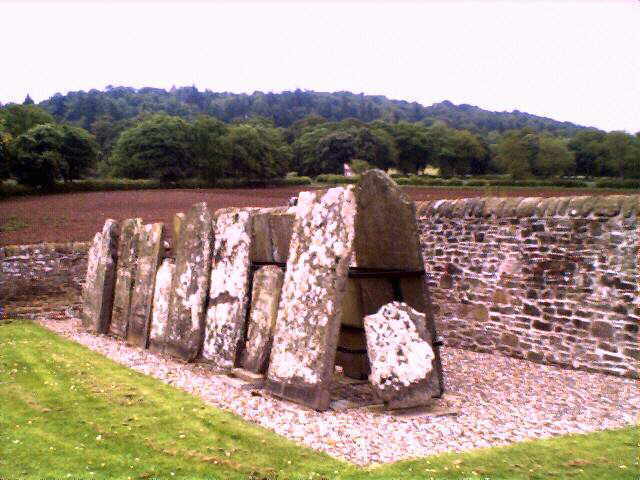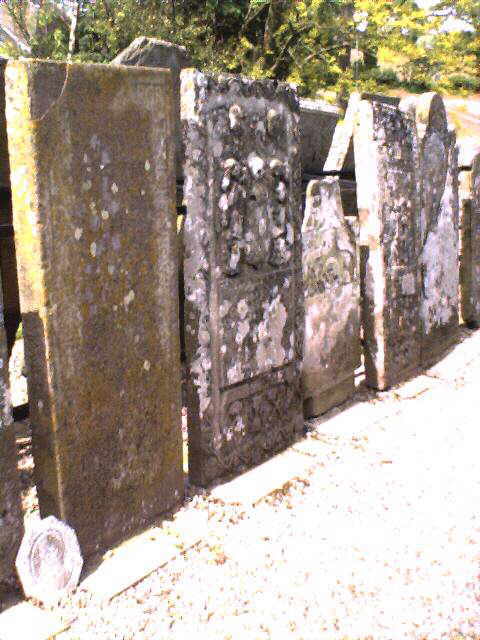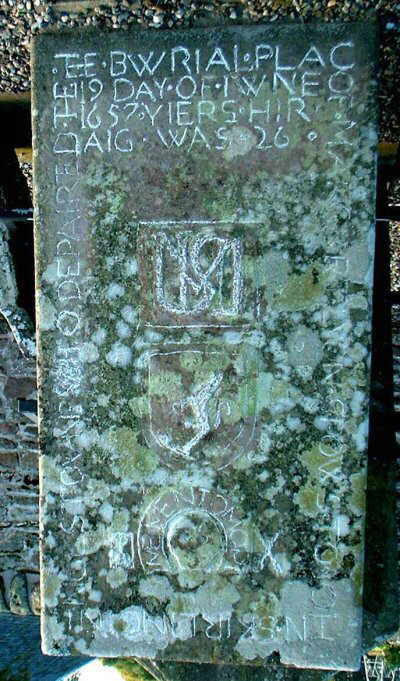 |
Close-up of the inscription of the SKIRLING stone #1. Some in Latin.
From SGS Book - #37 A Flat Stone (possibly was originally supported by four
pillars.) Inscription in Latin.
Christian Lon- - - - - Marg, Jo, Agn; (two cherubs; shield) Rob, Will,
Eliz Skirling (unclear).
Here is an original rough translation of the Latin but on review is
amended - see below.
"In this sepulchre on this day is committed (her) soul (to) the
Virgin and Holy Christ for ever after until the inevitable, our beloved
wife and mother Margret <the 'et' of Margret wraps to the
corner>
* Io (possibly John the father & husband?) * Agn(es) * Rob(ert) *
Will(iam) * Eliz(abeth) Skirling"
The space following SKIRLING appears to be completely blank - I really
did look again for more, but nothing to be seen. Problem is - NO
DATE/S. Were they elsewhere on the stone?
====================================================================
From CAG, 25 MAY 2005
The "rough translation" above wrongly implies that Margaret was the deceased and that John was possibly the
father and husband and the following gives an up-to-date opinion.
The stone begins: "In this terrible sepulchre on this day" and
goes into some fairly difficult text because of the lichen breaking
up the words and often hiding the very necessary root. Additionally,
there are some spelling errors in the Latin, suggesting the mason was not
at all literate in the language (occasionally typical of the stones of the
"country" gentry). For example "sepulchre", which in
Latin is 'sepulchrum' is spelled here "sepultur". Finally, it
was necessary to look
up 'grave' in English and work backwards from there to get back on track -
the insertion of the "t" was that problematic. Tenses and
conjugations are difficult, too, because of the obliteration by lichen,
and they don't often seem to match their context. The word 'terrible' (and
in this case an unusual choice, as the word used literally means
'sacrificial victim' or 'enemy') which modifies sepulchre at the very
beginning, appears about midway through the text.
The text picks up again fairly legibly at the the bottom when it
says "resolved Patrick, most beloved husband of Margaret with the
children John, Agnes, Robert William (and) Elizabeth Skirling."
It is not at all obvious from what can be made out of the intervening text
exactly WHOSE stone it is. There is a suggestion, based on the possible
plural of "animae" (souls), that the stone commemorates a couple
of family members, perhaps children, taken by an infectious illness. There is
also a suggestion that something terrible had
happened, because of the odd modifier for 'sepulchre'.
What is clear is that this is the family of Patrick Skirling in Brigton
(now Douglastown, nearby). He
was the father of William Skirling, burgess and baker in Dundee,
Convener of the Nine Trades. (This identification based on the names of the
children and the order of their appearance, oldest to last (except that Agnes
came AFTER Robert in baptismal order), all consistent with the kirk
records of this family.
The family may have included a Christian as suggested by the SGS, a
somewhat uncomfortable suggestion. The visible words on the stone
seem to refer to religious matters of souls, and suggest that
'Christ" is probably the word. Finally, what you can
read of the word is "C-H-I-R". The latter may have been another
mason's misspelling, but the only way to know for certain would be to
attempt to clean off the problematic text. In any event it "may
have included" because, while there was a Christian, daughter of
Patrick Skirling, baptised 10th June 1698, but ROBERT was baptised 25th
October 1698. The possibility of Christian being correctly with this
family cannot be ruled out because, with one exception, Patrick's
children are all recorded by their dates of baptism
and not birth. The order on the stone may be the correct birth order.
There are also two children missing from the stone who are known to have
lived to be adults. Both are known to have been siblings of
William based on their being called "aunt" and "uncle"
at the baptisms of his children in Dundee, namely a Margaret and a David.
(c.f: Margaret Skirline, baptised at Dundee 21st November 1736, 282/00/04,
and David Skirline, baptised Dundee 15th June 1730, 282/00/04). A satisfactory explanation for this
problem
cannot be offered at this time. Margaret,
daughter of Patrick Skirling of Scroggarfould, was baptised in Glamis 31st
Jan 1692, and that is consistent with known son John, son of Patrick
Skirling of Scrogarfould, baptised at Glamis on 23rd June 1693, and is
probably sufficient identification. David is a bit of a mystery - there is no record of a David born or baptised in these
years to a Patrick that has not already been identified as belonging to
other families. This could be considered unusual in a family that
seems to have recorded vital events rather methodically. All of the
other children and possible children are in the OPRs, most are on the
Kinnettles stone (or even on other stones in the Old Howff, Dundee and
Kinnettles), so this is odd.
The only explanation offered is that either David happened to have been
born away from home (if so, why wasn't he baptised at home?) or he *may*
have been born and baptised abroad. There is a 17-year gap between
the second to last and last child (Euphon, bapt 17th May 1706 at
Kinnettles, and Charles, baptised 5th May 1723,at Brigton,
Kinnettles). Euphon, also not included on the stone, very
probably died as a child. The same is possibly true for Charles -
but there is a LARGE gap between those two children.
The suggestion of the family being abroad is that, if the family was as
associated with the Lyons of Strathmore, as they appear to have been, then
there is a very real possibility that Patrick Skirling was involved in the
'15 and may have had to leave Scotland for a while. The IGI has no records
of Skirlings born in Continental Europe, but that doesn't mean they
weren't. The timing is awfully coincidental, and the family's associations
with the Lyons a bit too strong. The Lyons of Strathmore were known to
have been Jacobites, the fifth earl died at Sheriffmuir in 1715, and his
brother, Charles, the sixth earl, entertained the Old Pretender at Glamis
a year later. Other branches of the family seem, by substantive,
circumstantial evidence, to have had Jacobite leanings, and this is
especially true of the families that remained in, or near, Kinnettles and
Glamis.
It must be borne in mind, however, that William Skirling, burgess of
Dundee -- the William recorded on this stone as a child, was on the other
side of the issue. His son Cumberland was baptised in 1746, with the
Duke of Cumberland as his baptismal witness. (Dundee OPR 282/00/04).
Finally, the SGS says there were two cherubs and a shield between Agnes
and Rob, except, on looking at digital photos of the stone, these
are clearly in the centre - above the word "Skirling".
Their existence can be made out (one to the right of the shield, the
other to the left) but the shield is unclear. SOMEWHERE near
that shield will be the date, and it would be most interesting to
discover if there was anything on the shield.
The date on the stone will likely be near the shield in the middle, and if
something can be done for that Latin text, it would be worth looking
again.
|
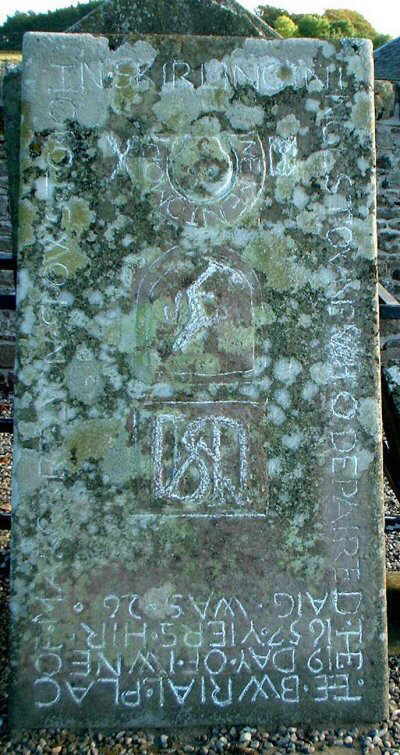 |
SKIRLING stone #3 (nearest).
From SGS book - #31 A Flat Stone (possibly was originally supported by four
pillars.
John Skirling in Inglistoune, wife Margrat Lyon died 19 June 1657 aged 26;
emblems (now unclear).
THE BWRIAL PLAC OF MARGRET LYON SPOWS TO IOHN SKIRLING IN INGLISTOWN
WHO DEPAIRTED THE 19 DAY OF IWNE 1657 YIERS HIR AIG WAS 26
(IOHN I for J, W for U)
Likely to be "The burial plaque (or place) of Margaret Lyon,
spouse of John Skirling in Ingliston, who departed 19 day June 1657 years
her age was 26"
The square symbol can be read to represent the entwined letters of JS and ML,
and the shield seems to be that of the LYON FAMILY of early days, similar
to that as appears on the LYON
family crest of Glamis Castle, nearby.
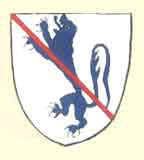
You can read a MS WORD document
for more detail. It has several graphics and can take quite a while
to download.
(Your virus checking software will likely ask you to SAVE and scan before
reading and you should always do so with any MS Word document.)
You can read HERE some more
about these old stones at Kinnettles, taken from - F. Davidson, "An
Inventory of 17th Century Tombstones in Angus" (1977, ten copies
only, held at the National Library and the Ancient Monuments Commission,
both in Edinburgh, at Dundee Central Library, and at the LDS library in
Salt Lake City. Supposedly it records the older stones in meticulous
detail and has illustrations of many. Interest here in pages 55-57.
|
